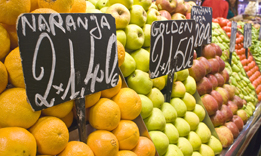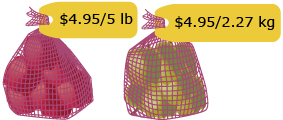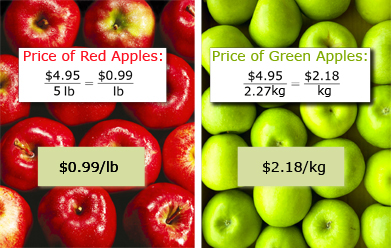Lesson 1
1. Lesson 1
1.3. Discover
Module 6: Proportional Reasoning
Discover

iStockphoto/Thinkstock
The expression “comparing apples to oranges” illustrates that, when comparing items, you must be aware of exactly what you are comparing. In other words, what is the purpose of your comparison? For instance, if you are trying to determine which brand of apples costs less, it is of no use to you to compare the prices of one brand of apples and one brand of oranges. You need to compare apples to apples.
Rates can be used to compare items. Recall that a rate is a ratio that has two terms that are measured in different units. The price of produce is commonly expressed as a rate, but the way that stores mark their prices sometimes makes it difficult to find the best value. For instance, the price of a bag of red apples is expressed as the rate $4.95/5 lbs. The price of a bag of green apples is expressed as the rate $4.95/2.27 kg. Both bags are the same price, but the units are different—5 lb versus 2.27 kg.
![]()

By only looking at the marked price of items, it isn’t always easy to determine which item is the best buy or has the best value. Both the red apples and the green apples are priced at $4.95.
Find something that the items have in common so you can compare them. Often when comparing items, you can calculate equivalent ratios that have the same unit in the second term of the ratio. If the second term of the ratio is 1, it is called a unit rate. In other words, a unit rate has a denominator of 1.
unit rate: a rate in which the numerical value of the second term is 1
For example, $4.50/6 bottles of pop expressed as a unit rate is $0.75/bottle. (When the second term is 1, it is not necessary to write the number, only the units.)
—Source: CANAVAN-MCGRATH ET AL. Principles of Mathematics 11, © 2012 Nelson Education Limited. p. 455. Reproduced by permission.
To determine the unit rate, divide the numerator by the denominator of the rate (or express the rate in its lowest terms). For example, the price of apples can be represented using a unit rate expressed as dollars per pound or dollars per kilogram as shown.

Red Apples: Brand X Pictures/Thinkstock; Green apples: Photos.com/Thinkstock
Although both types of apples have been expressed as a unit rate, you still can’t compare them as you are not using the same units in the second term. Instead, the apples are being compared price per pound to price per kilogram. In order to compare the value, the same units need to be compared.
Change the price of the red apples to be in $/kg. You know that 1 kg = 2.2 lb.
![]()
On the left side of the equation, lb on the bottom left will cancel out lb on the top right.
The unit rates of both the red apples and the green apples are the same, $2.18/kg, so both bags of apples have the same value.
Self-Check 1
Use the “Rates and Ratios (Food)” applet again to change various rates into unit rates. This time you will select “Topics” and choose “Topic 3: Rates and Unit Rates.”
